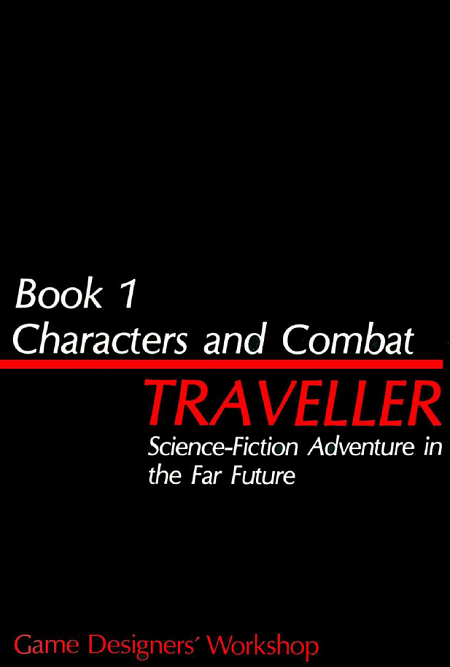Earlier this month, at Go Play Northwest, I played a game of Traveller Carcosa run by Alex Mayo that really made me want to play more Traveller. It also reminded me to prod my long-simmering, largely unrequited interest in Traveller and see if Mongoose Traveller was still my favorite iteration.
I then bumped into this post by Alex Schroeder about the nuances of sector generation in Classic Traveller (paid link; from The Traveller Book) and Mongoose Traveller (paid link) 1e, and that led me down a rabbit warren of Classic Traveller exploration.
What I learned was that there is at least as much meaningful variation in the nuances, presentation, expression, and philosophy of different versions of the Classic Traveller rules as there is in versions of old-school D&D.[1] I had no idea!

I love exploring this kind of stuff (and I’ve written about a bit of it myself; for example, my posts about B/X D&D), and just as it did with D&D, delving deeply into the seemingly innocuous variations in Traveller has led me to the realization that it’s the very first presentation, the 1977 versions of Books 1-3 that interests me the most, supplemented by The Traveller Book (paid link) for specific areas (like its tidy summary of the encounter rolls that form the basic structure of a campaign).
Interestingly, the only source for the 1977 version of Traveller that I’m aware of also happens to be one of the best deals in gaming: the Classic Traveller CD-ROM from Far Future Entertainment, which also includes the entire CT canon for just $35. Apart from that lone source, the later revisions of the original rules, notably the 1983 Traveller Book, have “taken over” and supplanted the 1977 version. The FFE CD, though, includes the original 1977 booklets, the 1981 revision, and The Traveller Book.
Classic Traveller love
Here are some of the branches in that rabbit warren, all great reads:
- This entire series of posts by Christopher Kubasik: Traveller Out of the Box. But specifically:
- From Den of the Lizard King, Traveller skill levels in context
- This paragraph-by-paragraph comparison of the 1977, 1981, 1982, and 1983 rules text by the indefatigable Frank Filz
Collectively, all of the above gave me a newfound appreciation for the original 1977 iteration of Traveller, as well as for the many parallels between Traveller Books 1-3 and OD&D’s original three LBBs, which embody a similar freewheeling, DIY, make-your-own-fun ethos.
When I — eventually! — get to run Classic Traveller, it’ll be with the 1977 rules (Books 1-3), The Traveller Book for some handy clarifications, and possibly, though only possibly, Supplement 4: Citizens of the Imperium (paid link) for alternate careers (but minus the Imperium stuff).
[1] And that’s not even considering all of the other full-on different editions, like MegaTraveller (paid link) and whatnot.

Thanks for the kind words a links to my Traveller: Out of the Box series.
A quick comment: A lot of people balk (or freak) out at the rules found on Classic Traveller because there is no unified skill or task system in the game.
But there is a *situation* system. It simply isn’t like the systems we are used to post-1977 — when skill systems began to take shape.
I would recommend that anyone confused by how to Referee Classic Traveller check out these two posts. The first gives context to the gaming culture that Classic Traveller was grown from, the second outline how to use the rules at hand to play the game.
I ran an off the cuff convention game a couple of months ago using the rules as described in the posts below and it worked great.
https://talestoastound.wordpress.com/2017/01/06/traveller-out-of-the-box-an-approach-to-refereeing-and-throws-in-original-traveller-part-i/
https://talestoastound.wordpress.com/2017/05/15/traveller-out-of-the-box-a-summation-of-my-thoughts-on-throws-in-original-traveller-part-ii/
Thanks for the follow-up links, Chris!
When I first read CT, the absence of a unified task resolution system is what sent me to TTB, then to Mongoose 1e. I thought Mongoose 1e was going to be my Traveller jam, and put all of my other versions in storage.
. . . And then I got to actually play Classic, and saw what I’d been missing. Your posts, including the two you linked, took me a lot further down that path.
Absolutely good stuff, and thanks for the referral to my document. When folks reference it, I always like to remind folks that I welcome additional commentary or pointers to differences I missed (or didn’t feel were significant, but may be significant to someone else). If you have a comment to make, just request commenting access to the document.
I’ve got a CT reprint but I don’t know if it’s the ’77 or the revision from the 80s. Is there an easy way to tell?
The quickest way I know of is to check the copyright line at the front of the book: If it lists any years other than 1977, it’s not the 1977 version, e.g. “1977 and 1981.”
If you have a reprint, I believe — though I’m not 100% certain — that all the reprints use a later version. All of mine do, in any case.
Does Book 3 talk about determining space lanes? That’s a sure sign of ’77. If Book 1 does not give Scouts 2 skills per term is another key to ’77. Another key to ’81 is if the Rank and Service Skills table is on the same page as the Acquired Skills Tables.